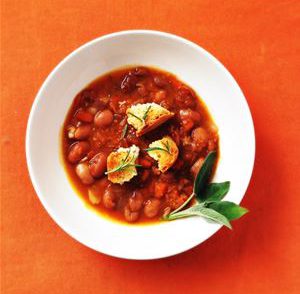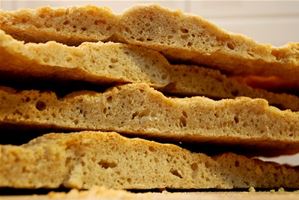With spring well under way and with the puntarelle season now finished, it is time to start planting my garden for spring and summer fare: cetrioli, melanzane, pomodori, pomodorini, basilico, zucchine, cipolle rosse, and more.
When the plant seller I recently visited at Sant’Ambrogio market asked if I wanted to buy an aromatic plant with pretty flowers to plant near my tomatoes, I asked him if it was edible. ‘No,’ he said, ‘but it works like an insect repellent, enticing them to this smelly plant and away from the tomatoes.’
‘I use basil for that,’ I replied, ‘and I can eat it, too. Then I can pick up a mozzarella di bufala at the market and have an insalata caprese any time I please. Why on earth would I plant something that looks nice but that I can’t eat?’
Indeed, my garden itself set the precedent. The plants that were already in my fazzoletto di giardino when I became its tender were recently planted-that is, planted within the last century-and each produces something that’s useful in the kitchen. Along with the banana tree and the bay hedge are an olive tree that the local cats use to breach the old Roman wall; a miniature melograno under which I plant my lettuces; and three different types of roses, from which I make candied rose petals, or a rose petal sauce, or throw into a green salad to give fragrance and extra colour.
However, every time I ask the plant seller for seeds he goes crazy. ‘For what? You are not thinking of planting now are you?’, he said the last time I dared ask the question.
‘I wouldn’t dream of it,’ I said, not knowing why.
He took me to the calendar on the wall to explain what I could and could not think of doing in my garden: ‘When the moon is waxing, becoming full, you can sow seeds and plant seedlings of vegetables that grow above ground. So, right now, I will let you have the tomatoes, the cucumber and the basil that you want. Come back in a couple of weeks for the potatoes, onions and carrots, which I will let you plant when the moon is waning. Wait two more weeks for the lettuce, for the overnight warmth and to keep in rhythm; otherwise, you will be outside of the lunar cycle. Didn’t you grow up learning this? What do they teach you where you come from?’
Well, yes, I had heard of planting according to the moon, but the best piece of advice he gave me recently was indeed completely new to me. When choosing seeds from your plants to keep for the next season, he advised, pick the seeds from the first fruit of the crop. If you have a tomato plant that grows tall and strong, for example, pick the first tomato and set aside its seeds; these will give you a plant full of fruit the following year. However, if you wait until the end of the season and take one of the last tomatoes from the end of the crop, it will inevitably come from the top of the vine. These seeds will produce a great lusty vine that bears no tomatoes until it has reached the height from which the ‘starter’ tomato was picked.
THREE VERNACCIA FOR SPRING
I’ve gone crazy for Mattia Barzaghi’s Vernaccia di San Gimignano, with its distinctive mineral tones with a touch of vanilla in the oaked varieties. All the varieties are made by Mattia, the passionate and highly talented wine maker from Bergamo in the north of Italy, who now lives in San Gimignano. Mattia produces such a good Vernaccia wine that the local consortium in San Gimignano uses it as the perfect example of what a Vernaccia should be. I must admit I’d never been crazy about this Tuscan white grape varietal. However, Mattia knows how to cajole each fragrant drop out of what is often a less flavourful and aromatic wine. Last year, when I offered to send a colleague to help pick his grapes, Mattia was almost offended! He does it all himself. Go figure! But, above all, go taste!
Impronte
Vernaccia di San Gimignano DOCG 2009
100% Vernaccia di San Gimignano
The first wine under Mattia Barzaghi’s own label, the name of the wine translates to ‘fingerprints.’ Smooth and steely, minerally, honest and simple, and unpretentious, it hides nothing, and a clear, clean freshness comes through. It rolls around on your tongue like ball bearings, leaving a fresh and very elegant steely finish.
Zeta
Vernaccia di San Gimignano DOCG 2009
100% Vernaccia di San Gimignano, fermented in oak barrels
After producing Impronte, Mattia named his second wine after his favourite dog, who is pictured on the label. The wine sits in French oak barrels for four or five months, rounding out the minerality of the grape. Notes of vanilla on the nose with a tiny pinch of spice.
Cassandra
Vernaccia di San Gimignano DOCG 2008
100% Vernaccia di San Gimignano, fermented in oak barrels
Mattia saved the best for last, naming his third wine after his wife. Cassandra is his piece di resistance, another 100 percent Vernaccia di San Gimignano, but this time a riserva with balance, finesse and elegance. For Cassandra, the vinification process is longer, and the wine offers a longer finish with more depth.
At the moment, the only thing that is ready in my garden is my mint, which I pair with spring peas from the market and prawns to make a delicious spring risotto.
Spring pea, prawn, and garden mint risotto
(pairs well with Zeta)
1 onion
2 cloves spring garlic
120 g butter
80 g extra virgin olive oil
400 g Arborio rice
1 bunch fresh garden-variety mint
200 g prawns
1 glass of Zeta Vernaccia di San Gimignano
200 g shelled spring peas
vegetable stock
peperoncino to taste
Finely dice the onion and sauté in the olive oil and half the butter for about 4-5 minutes, stirring constantly with a wooden spoon. Add the chopped garlic and throw in the rice at the same time to toast, so the garlic won’t burn. Turn down the heat and toast the rice, coating it in the olive oil from cooking the onions for about 3 minutes, until the rice is partly translucent. Throw in the whole glass of Zeta and continue to stir.
Add the whole mint stalks. Add vegetable stock one ladle at a time and, while the rice absorbs this, continue to stir. Halfway through cooking, about 6 minutes, depending on the quality of the rice, throw in the peas and the prawns and continue to stir with a wooden spoon, adding a small amount of liquid when necessary.
When the rice is al dente, add an extra ladle of vegetable stock and remove from the flame. Discard the mint stalks, add the chopped mint leaves, and season to taste with sea salt flakes and peperoncino. If you really want to add another note of flavour to the risotto, finish with a light grating of pecorino stagionato, using just a little so it doesn’t mask the flavour of the prawns.
Pour yourself a glass of Zeta and enjoy!







